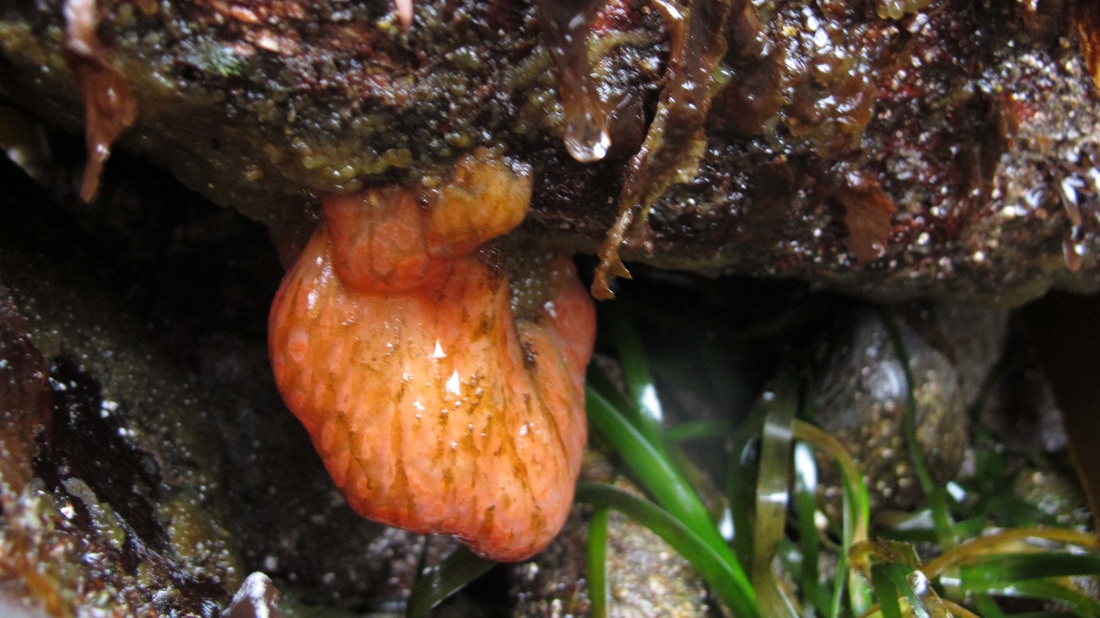Red ascidian, sea pork • Aplidium solidum
Identification
This compound ascidian forms a lumpy, slab-like colony, consisting of bright red zooids (individual members within the colony) encased in a reddish fleshy or gelatinous mass. The zooids vary in length (average 12 mm long) and are arranged in small, irregularly-shaped systems. Colonies have been measured to 20 cm across and up to 5 cm thick, though 2-3 cm is more common.
Habitat & Range
Red ascidian colonies grow on rock and pilings in areas exposed to currents. It is a relatively common species that is found in the intertidal and subtidal to 40 m deep, from British Columbia to southern California.
Similar Species
Compound tunicates can be tricky to ID: not only can they be difficult to distinguish from each other, but they can even be hard to tell apart from similarly amorphous encrusting sponges. There are a number of reddish-coloured species of both groups found in coastal BC waters. The California sea pork (Aplidium californicum) is one such ascidian: forms thinner slabs (1-2 cm thick), has smaller zooids (6 mm long), and is duller and more variable in colour. Another similar species is the red-dotted compound tunicate (Eudistoma molle), which is more opaque and whitish with red, irregularly-placed zooids.
Intriguing Info
The opalescent nudibranch (Hermisseda crassicornis) feeds on red ascidian zooids.
This compound ascidian forms a lumpy, slab-like colony, consisting of bright red zooids (individual members within the colony) encased in a reddish fleshy or gelatinous mass. The zooids vary in length (average 12 mm long) and are arranged in small, irregularly-shaped systems. Colonies have been measured to 20 cm across and up to 5 cm thick, though 2-3 cm is more common.
Habitat & Range
Red ascidian colonies grow on rock and pilings in areas exposed to currents. It is a relatively common species that is found in the intertidal and subtidal to 40 m deep, from British Columbia to southern California.
Similar Species
Compound tunicates can be tricky to ID: not only can they be difficult to distinguish from each other, but they can even be hard to tell apart from similarly amorphous encrusting sponges. There are a number of reddish-coloured species of both groups found in coastal BC waters. The California sea pork (Aplidium californicum) is one such ascidian: forms thinner slabs (1-2 cm thick), has smaller zooids (6 mm long), and is duller and more variable in colour. Another similar species is the red-dotted compound tunicate (Eudistoma molle), which is more opaque and whitish with red, irregularly-placed zooids.
Intriguing Info
The opalescent nudibranch (Hermisseda crassicornis) feeds on red ascidian zooids.
References
Cowles, D. (2008). Aplidium solidum (Ritter and Forsyth, 1917). Invertebrates of the Salish Sea. Rosario Beach Marine Laboratory. Accessed 01/12/2015.
Lamb, A., and Hanby, B. (2005). Marine Life of the Pacific Northwest [electronic version]. Madeira Park, BC: Harbour Publishing.
Watanabe, J. (2011). Phylum Chordata, Subph. Urochordata: Subtidal Tunicates. SeaNet: Common Marine Organisms of Monterey Bay, California. Stanford University, Stanford, CA. Accessed 01/12/2015.
Authors and editors of page
Kelly Fretwell (2015).
Cowles, D. (2008). Aplidium solidum (Ritter and Forsyth, 1917). Invertebrates of the Salish Sea. Rosario Beach Marine Laboratory. Accessed 01/12/2015.
Lamb, A., and Hanby, B. (2005). Marine Life of the Pacific Northwest [electronic version]. Madeira Park, BC: Harbour Publishing.
Watanabe, J. (2011). Phylum Chordata, Subph. Urochordata: Subtidal Tunicates. SeaNet: Common Marine Organisms of Monterey Bay, California. Stanford University, Stanford, CA. Accessed 01/12/2015.
Authors and editors of page
Kelly Fretwell (2015).




